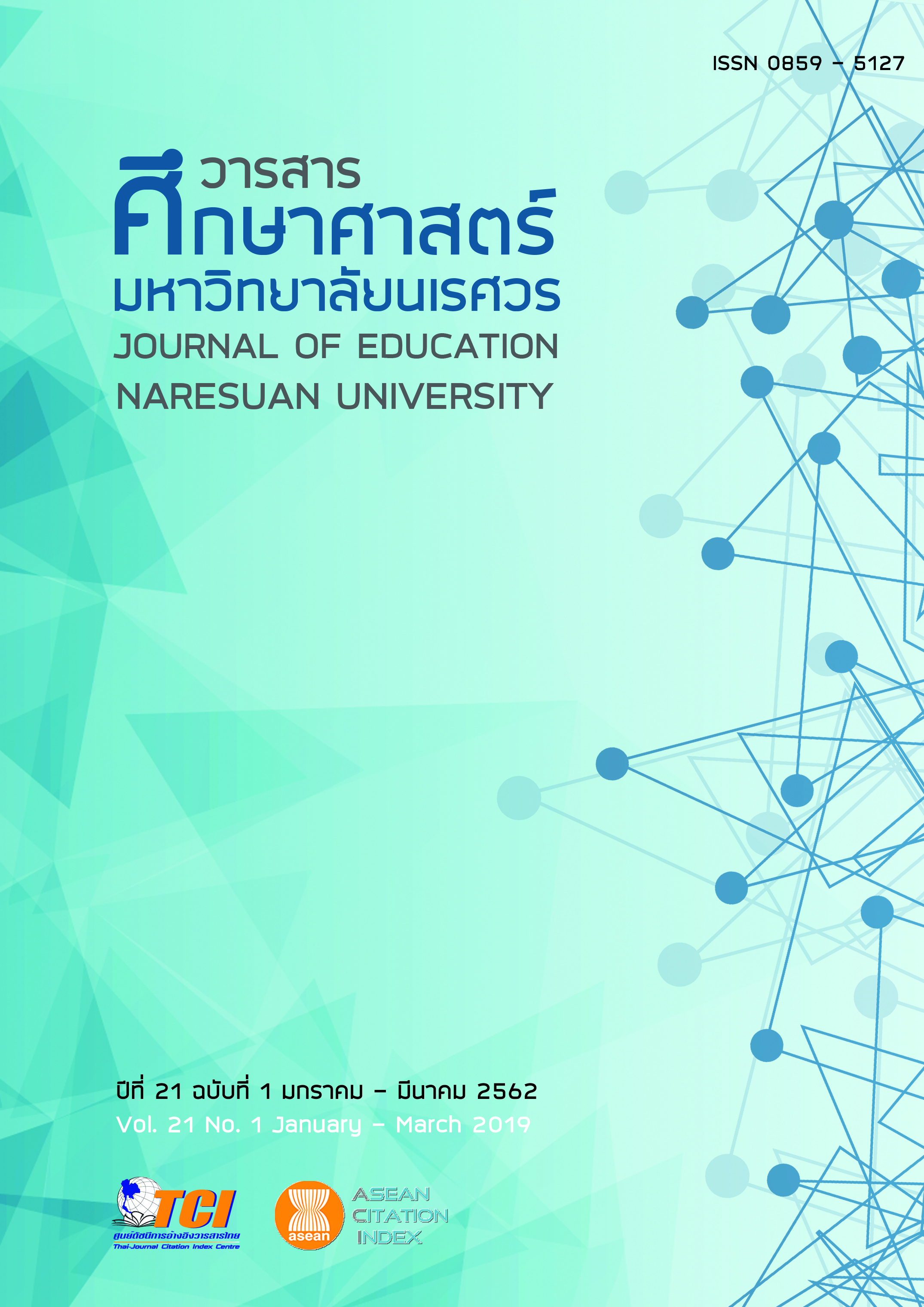การพัฒนารูปแบบการจัดการเรียนรู้วิทยาศาสตร์ตามแนวการเรียนรู้อย่างกระตือรือร้นและการช่วยเสริมศักยภาพ เพื่อส่งเสริมความสามารถในการแก้ปัญหาอย่างมีวิจารณญาณ สำหรับนักเรียนชั้นมัธยมศึกษาตอนปลาย (THE DEVELOPMENT OF SCIENCE INSTRUCTIONAL MODEL BASED ON ACTIVE LEARNING AND SCAFFOLDING TO ENHANCE CRITICAL PROBLEM-SOLVING ABILITIES FOR UPPER SECONDARY STUDENTS)
Main Article Content
Abstract
การวิจัยนี้มีวัตถุประสงค์ เพื่อพัฒนารูปแบบการจัดการเรียนรู้วิทยาศาสตร์ตามแนวการเรียนรู้อย่างกระตือรือร้นและการช่วยเสริมศักยภาพ สำหรับนักเรียนชั้นมัธยมศึกษาตอนปลาย มีขั้นตอนการวิจัย 3 ขั้นตอน ได้แก่ ขั้นที่ 1 ศึกษาการจัดการเรียนรู้วิทยาศาสตร์ตามแนวการเรียนรู้อย่างกระตือรือร้นที่ส่งเสริมความสามารถในการแก้ปัญหาอย่างมีวิจารณญาณ ขั้นที่ 2 การสร้างและตรวจสอบคุณภาพรูปแบบการจัดการเรียนรู้วิทยาศาสตร์และขั้นที่ 3 ศึกษาผลการใช้ของรูปแบบการจัดการเรียนรู้วิทยาศาสตร์กับนักเรียนชั้นมัธยมศึกษาปีที่ 4 โรงเรียนเนินพิทยาคม จังหวัดเพชรบูรณ์ จำนวน 32 คน ภาคเรียนที่ 2 ปีการศึกษา 2559 เครื่องมือที่ใช้ในการวิจัย ได้แก่ รูปแบบการจัดการเรียนรู้วิทยาศาสตร์ตามแนวการเรียนรู้อย่างกระตือรือร้นและการช่วยเสริมศักยภาพ แบบวัดความสามารถในการแก้ปัญหาอย่างมีวิจารณญาณ และแบบประเมินความสามารถในการแก้ปัญหาอย่างมีวิจารณญาณที่ใช้ประเมินระหว่างเรียน การวิเคราะห์ข้อมูลโดยหาค่าร้อยละ ค่าเฉลี่ย ส่วนเบี่ยงเบนมาตรฐาน การทดสอบทีแบบไม่อิสระ (t-test dependent) ผลการวิจัย พบว่า
1. แนวคิดการจัดการเรียนรู้วิทยาศาสตร์ตามแนวการเรียนรู้อย่างกระตือรือร้นและการช่วยเสริมศักยภาพที่ส่งเสริมความสามารถในการแก้ปัญหาอย่างมีวิจารณญาณ ระดับชั้นมัธยมศึกษาตอนปลาย เป็นการเรียนรู้ร่วมกันมีการ บูรณาการเทคโนโลยี ผู้สอนปรับเปลี่ยนบทบาทเป็นผู้อำนวยความสะดวกและผู้ชี้แนะ นักเรียนเป็นผู้ลงมือปฏิบัติในกิจกรรมทางวิทยาศาสตร์อย่างหลากหลาย รับผิดชอบและกำกับการเรียนรู้ของตนเอง มีการสะท้อนคิดเพื่อปรับปรังการเรียนรู้ให้ดีขึ้น และมีการประเมินนักเรียนตามสภาพจริงจากการปฏิบัติ และการช่วยเสริมศักยภาพ ผู้สอนควรออกแบบการช่วยเหลือให้เหมาะสมกับระดับความสามารถของผู้เรียน นักเรียนกลุ่มที่มีความสามารถสูง ควรส่งเสริมให้เป็นผู้เชี่ยวชาญช่วยเหลือกลุ่มที่มีความสามารถต่ำ
2. การสร้างและตรวจสอบคุณภาพรูปแบบ พบว่า 1) รูปแบบการจัดการเรียนรู้วิทยาศาสตร์ตามแนววิทยาศาสตร์ ตามแนวการเรียนรู้อย่างกระตือรือร้นและการช่วยเสริมศักยภาพ สำหรับนักเรียนชั้นมัธยมศึกษาตอนปลาย ที่สร้างขึ้นมีชื่อว่า 2G-CPS Model มีกระบวนการเรียนรู้ ดังนี้ ขั้นที่ 1 กำหนดเป้าหมายการเรียนรู้ (G1 : goal of learning) ขั้นที่ 2 ชี้นำประสบการณ์ (G2 : guide to experience) ขั้นที่ 3 ร่วมมือแก้ปัญหา (C : collaborate to solve problem) ประกอบด้วยการฝึกการแก้ปัญหาอย่างมีวิจารณญาณตามกระบวนการ 5 ขั้น ได้แก่ (1) ระบุปัญหาหรือตั้งคำถาม (2) รวบรวม/การจัดการข้อมูล (3) วางแผนแก้ปัญหาหรือหาคำตอบ (4) ดำเนินการแก้ปัญหาหรือหาคำตอบ (5) ประเมินผลการแก้ปัญหาหรือหาคำตอบ ขั้นที่ 4 นำเสนอสะท้อนคิด (P: presentation and reflection) และ ขั้นที่ 5 แบ่งปัน สู่สาธารณะ (S: share to public) 2) ผลการตรวจสอบคุณภาพของรูปแบบการจัดการเรียนรู้โดยผู้ทรงคุณวุฒิ พบว่า รูปแบบที่พัฒนาขึ้นมีคุณภาพอยู่ในระดับมาก (=4.36, S.D. = 0.58) และ 3) เมื่อนำรูปแบบที่พัฒนาขึ้นไปทดลองใช้ พบว่า มีค่าดัชนีประสิทธิผล เท่ากับ 0.6143
3. ผลการใช้รูปแบบการจัดการเรียนรู้วิทยาศาสตร์ที่พัฒนาขึ้น พบว่า 1) นักเรียนมีความสามารถในการแก้ปัญหาอย่างมีวิจารณญาณหลังเรียนสูงกว่าก่อนเรียน อย่างมีนัยสำคัญทางสถิติที่ระดับ .05 2) นักเรียนมีความสามารถในการแก้ปัญหาอย่างมีวิจารณญาณหลังเรียนสูงกว่าเกณฑ์ร้อยละ 75 อย่างมีนัยสำคัญทางสถิติที่ระดับ .05 และ 3) จำนวนนักเรียนที่มีความสามารถในการแก้ปัญหาอย่างมีวิจารณญาณในระดับสูงมีแนวโน้มเพิ่มขึ้น จำนวนนักเรียนที่อยู่ในระดับต่ำมีแนวโน้มลดลง
THE DEVELOPMENT OF SCIENCE INSTRUCTIONAL MODEL BASED ON ACTIVE LEARNING AND SCAFFOLDING TO ENHANCE CRITICAL PROBLEM -SOLVING ABILITIES FOR UPPER SECONDARY STUDENTS
The purpose of this research was to develop science instructional model based on active learning and scaffolding to enhance critical problem-solving abilities for upper secondary students. The research procedure comprised of 3 steps. Step 1: the study of science learning based on active learning to enhance critical problem-solving abilities. Step 2: to develop and verify the quality of science instructional model. Step 3: to implement the science instructional model. The samples were 32 of upper secondary students, selected by purposive sampling method, of Nernpittayakhom school in Petchabun province. In the 2nd semester of the 2016 academic year.The research instruments were a multiple-choice test of critical problem-solving abilities and a critical problem-solving abilities assessment was used during class. The statistical data analyses are percentage, mean, S.D. and t – test dependent. The results of the research study were as follows:
1. The Concept of scientific learning management and scaffolding based on an active learning to enhance the critical problems abilities for upper secondary school is collaborative learning. It integrates information communication and technology. The teacher can change role as facilitators and coach. Students act in a variety of scientific activities and responsible their learning. Learning is reflected to improve education. Student assessment based on actual practice. Scaffolding is used to enhance critical problem-solving. Instructors should design to scaffolding suit their level of competence. Highly qualified students should be promoted to a specialist to help low-performing groups.
2. The creation and quality inspection of the model found that : 1) The developed model called 2G – CPS Model. It has a learning process in 5 steps contained step 1: G1, Goal of learning, step 2: G2, Guide of experience, step 3: C, collaborate to solve the problem (this step consists of 5 step of critical problem solving was (1) identify problems or questioning. (2) Data collection/ management. (3) Plan to solve problems or find solutions. (4) Solve problems or find solutions. (5) Evaluate the solution, Step 4 : P, Presentation and Reflection, Step 5: S, Share to public. It had high levels of appropriateness (= 4.36, S.D. = 0.58). 2) The effectiveness index (E.I) was 0.6143.
3. The effect implementation was: 1) the students had a critical problem - solving abilities after learned with the developed model was higher than before at the .05 level of statistical significance. 2) the students had a critical problem - solving abilities after learned through the developed model was higher than 75 percent criterion at the .05 level of statistical significance. 3) the number of students with critical problem - solving abilities at a high level had increased trend of a percent amount while a low level had decreased.
Article Details
The owner of the article does not copy or violate any of its copyright. If any copyright infringement occurs or prosecution, in any case, the Editorial Board is not involved in all the rights to the owner of the article to be performed.
References
Bonwell, C. C., & Eison, J. A. (1995). Active learning: Creating excitement in the classroom AEHE-ERIC higher education report No. 1. Washington, D.C.: Jossey-Bass.
Dabbagh, N. (2003). Scaffolding: An important teacher competency in online learning. Tech Trends, 47(2), 39-44.
Department of Academic Affairs. (2002). Manual of learning area of science based on the basic education core curriculum B.E. 2544 (A.D. 2001). Bangkok: Shipping and Packing Organization. [in Thai]
Joyce, B., & Weil, M. (2001). Models of teaching (5th ed.). Massachusetts: Allyn and Bacon.
Kaewurai, W. (2011). The development of Instruction model to improve the quality of learners into a moral society wisdom and learning. Journal of graduate Nakhon Sawan Rajabhat University, 6(15), 11-30. [in Thai]
Khaemmani, T. (2010). Instruction science: Knowledge for effective learning management. Bangkok: Chulalongkorn University Press. [in Thai]
Khiaolueang, D., Kaewurai, W., Hingkanon, P., & Viboonrangsun, S. (2013). The development of the thought reflection learning model to enhance ethical decision-making in nursing for student nurses. Journal of Education Naresuan University, 15(4), 9-21. [in Thai]
Larkin, M. J. (2001). Providing support for student independence through scaffold instruction. Teaching Exceptional Children, 34(1), 30-34.
Manopichetwattana, S. (2004). The development of integrated science instruction emphasizing active learning on the human body (Doctoral Dissertation). Bangkok: Srinakharinwirot University. [in Thai]
National Research Council. (1996). National Science Education Standards. New York: National Academy Press.
North Central Regional Educational Laboratory. (2004). Critical issue: Rethinking learning for students at risk. Retrieved December 12, 2007, from https://www.ncrel.org/sdrs/areas/issues/students/atrisk/at700.htm
Partnership for 21st Century. (2008). 21st century skills: Rethinking how students learn. Retrieved February 17, 2008, from https://www.21STCENTURY.ORG/
Puntambekar, S., & Kolodner, J. L. (2005). Distributed scaffolding: Helping students learn science by design. Journal of Research in Science Teaching, 42.
The Institute for the Promotion of Teaching Science and Technology. (2016). Press conference of Evaluation results in PISA 2015. Retrieved November 7, 2016, from https://pisathailand.ipst.ac.th/news/pisa2015result [in Thai]


